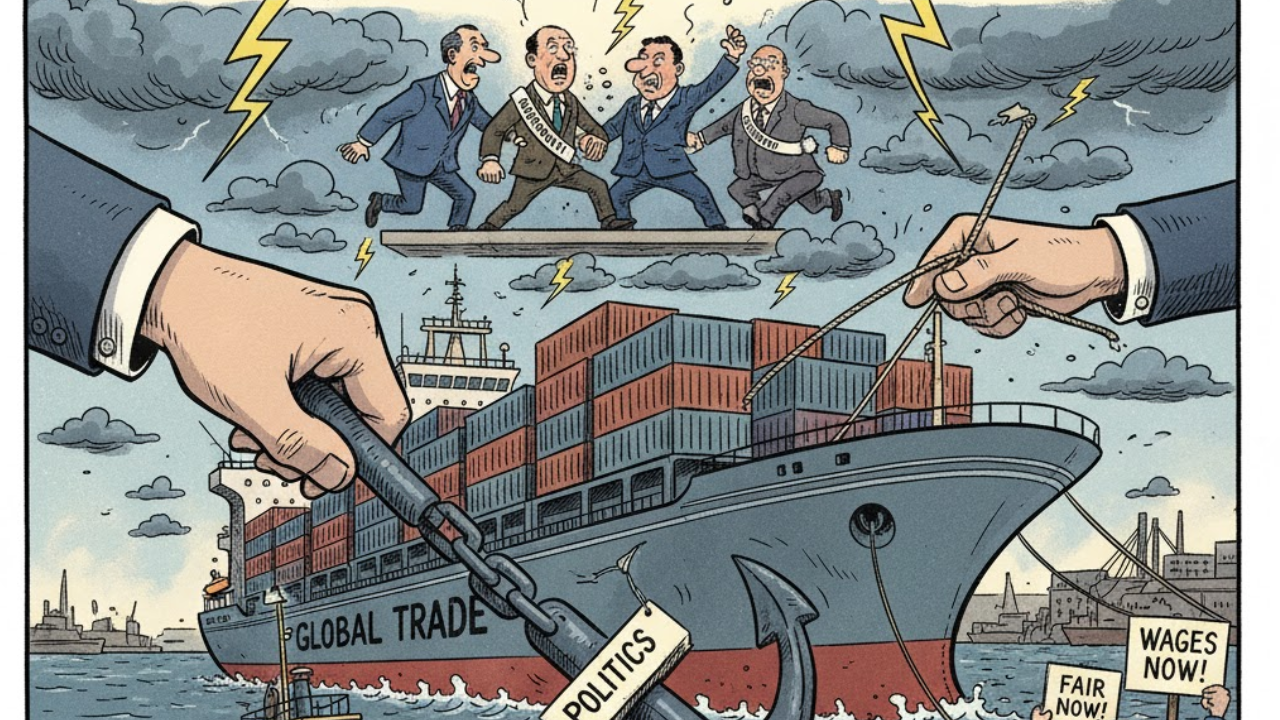
Post by : Naveen Mittal
Port congestions, vessel queues and cargo delays make headlines — but behind those disruptions lie deeper tensions in labour relations and political dynamics. The October 2025 harbour pilots’ industrial action at Antwerp-Bruges is a case in point: it reveals how technical workers, pension reform, union leverage and government policy collide in contested maritime spaces. Understanding these intersections is essential for carriers, shippers, governments and stakeholders to better anticipate, mitigate and navigate port disruptions.
Harbour pilots, towage crews, lock operators, and terminal labour are highly specialized and often legally mandatory services for port entry/exit. Their withdrawal (strike, go-slow, work-to-rule) can immediately bottleneck operations. Because ports are chokepoint infrastructure, labour has a disproportionate negotiating leverage — small disruptions can magnify across supply chains.
In effect, labour at ports acts as a strategic lever: controlling vessel access, scheduling, berth allocation and operational cadence. This leverage elevates labour disputes in ports from local grievances to systemic economic risks.
The dispute stemmed from proposed changes to pension reform at the federal level, which harbour pilots perceived as detrimental to their retirement security. The pilots initiated go-slow operations, followed by full withdrawal of overtime and stricter adherence to regulations (limiting hours and assignments per shift). Negotiations followed, but the disruption had already built up significant backlog.
Over several days in mid-October 2025, pilot availability dropped sharply. Vessel queues swelled to nearly 188 ships at anchor, port throughput contracted to ~70% of normal, and carriers announced reroutes or delays. The port authority warned that it would take days to clear the backlog even if normal operations resumed. The pilots later agreed to resume operations under interim arrangements while negotiations continued.
The dispute involved multiple levels:
Pilots’ unions and representative bodies, advocating terms, pensions, working conditions.
Federal government ministries (labor, transport, pension oversight), which proposed or defended reform.
Port authority and port management, caught between keeping operations running and respecting labour law.
Shipping lines, terminal operators, energ y users expressing economic pressure for resolution.
Regional political entities and public opinion, which may side with labour or commerce depending on social impact.
The interplay of union pressure, public relations risk, and economic cost shaped the negotiation dynamics.
Pilots viewed the proposed federal pension changes as undermining secure retirement conditions for a relatively narrow, high-stress technical workforce. The symbolic value of defending pension rights gave moral justification to disruptive labour action. Governments often see pension reform as essential for fiscal sustainability — setting up a clash between collective bargaining and public finance.
Pilots (and unions) often seek public sympathy: framing their fight not merely as self-interest but protecting technical safety standards and sustainable retirement. Media coverage and narratives matter — public backlash over fuel or cargo shortages can pressure government to negotiate more quickly.
Governments facing electoral pressures, budget constraints, or coalition instability may be more vulnerable to labour disruption. Pilots may time strikes to coincide with sensitive budget cycles, public events, or when alternative routes are weak. Labour actions in critical infrastructure often carry political overtones beyond labour policy.
In some jurisdictions, governments may legally limit disruption of critical infrastructure (essential services laws) or impose minimum service levels. Governments may also intervene as mediator, propose “essential services” carve-outs or guarantees, or legislate labour terms unilaterally. Such interventions change incentive structures for both sides.
Port labour unions often operate in regulated and semi-public domains (ports, pilotage), giving them structural role. Their contracts and negotiations often involve public oversight, legislative mandates, pension commitments, and cross-sector bargaining coalitions. This structural embedding elevates port labour beyond pure private labour calculation.
Vessel queuing and delays.
Bunkering and fuel deliveries derailed.
Cargo schedule cascading through inland logistics, rail/road delays.
Increased demurrage, detention, penalty claims.
Rerouting ships to alternate ports, increasing voyage cost and time.
These disruptions raise freight costs, supply chain risk premiums and commodity price volatility. Industries downstream reliant on timely imports or exports (fuels, chemicals, perishables) may experience input price inflation or supply stress.
Ports struggling with disruption suffer reputational harm. Shipping lines may reduce reliance on vulnerable ports, shift schedules toward more resilient hubs, or renegotiate contracts to reduce exposure.
Shippers and carriers may trigger force majeure, dispute demurrage, or renegotiate delivery terms. The burden of liability — whether labour action is considered excusable disruption — becomes contested. Insurance and P&I clubs may scrutinize claims.
Over time, sustained disruption risk may encourage shipping networks to reduce concentration on high-risk ports, diversify routes, build redundancy, or invest in alternative infrastructure (rail, inland ports, feeder systems).
Pre-negotiated frameworks: Implement prior agreements (essential service protocols, minimum labour levels) for critical infrastructure to limit escalation.
Tripartite forums: Maintain continuous dialogue among unions, operators and government to prevent surprises.
Regulated labour frameworks: Where necessary, classify certain port roles as “critical infrastructure” with mediation or essential services limitations.
Transparent reform design: Pension or labour changes must be inclusive, well communicated, and phased to avoid perceptions of unfairness.
Disruption compensation mechanisms: Establish contingency funds or insurance schemes to absorb shock impacts on trade, particularly for exposed industries.
Labour risk assessment: Map vulnerability to labour action, identify critical roles, and develop redundancy or surge protocols.
Alternate operations playbooks: Prepare standby contracting, shifting to backup ports, or partial operation modes in disruption.
Incentive alignment: Use contractual incentives or revenue sharing models with labour groups to link performance to port throughput or revenue gains.
Real-time communications: Develop robust stakeholder communication systems to manage customer expectations and rescheduling.
Legal readiness: Structure contracts, clauses (force majeure, labour risk sharing) to clearly allocate responsibilities and documentation.
Strategic targeting: Focus on maximal leverage roles (pilots, towage) but avoid overreach that triggers backlash.
Public narrative framing: Articulate safe operations, pension security and public value to maintain legitimacy.
Phased escalation: Use incremental measures (go-slow, overtime refusal) before full strikes to signal gravity and preserve negotiation space.
Mobilize broad support: Build alliances with communities, users and local governments to increase leverage beyond immediate members.
Labour risk becomes part of port investment calculus: Investors and operators will price disruption risk in port valuation and capex decisions.
Automation and digital substitution: To reduce reliance on constrained labour roles, ports may accelerate automation, remote pilotage, AI scheduling and robotics.
Decentralization and redundancy: Port authorities may promote distributed port networks, feeder systems, inland logistics buffers.
Labour reform and modernization: Labour contracts, benefit structures and retirement systems may require modernization aligned with demographic and fiscal realities.
Regulatory modernization: Governments may update labour law frameworks to better balance rights with strategic imperatives for critical infrastructure.
Q: Why do pilots hold so much power?
Because for many ports, pilotage is mandatory and a bottleneck. Reducing pilot availability immediately constrains vessel movement, amplifying labour leverage.
Q: Can government always compel labour to maintain operations?
In many jurisdictions, essential services laws allow government oversight, mediation or limits on strike action. But political, legal or constitutional limits constrain such intervention.
Q: What is a “go-slow” tactic by labour?
Instead of full strikes, workers reduce productivity by adhering rigidly to rules, limiting overtime, slowing transfers — creating capacity bottlenecks without formally striking.
Q: Who usually bears the cost in port strikes?
Often downstream shippers, commodity users, fuel importers, terminal operators and liners absorb costs via delays, demurrage, rerouting or surcharges.
Q: How can ports better prepare for labour disruption?
Through contingency plans, alternative routing, contractual protections, continuous labour dialogue, and resilience investments like automation and redundancy.
Port disruption is rarely just a technical failure — it is the intersection of supply chains, labour, governance, and political economy. The Antwerp pilots’ strike in 2025 shows how a small segment of highly specialized workers, by withholding their services, can paralyze a major logistics node and send shockwaves across global trade.
Long-term resilience depends on recognizing this nexus. Governments, operators and unions must engage proactively, build frameworks to manage disputes, and balance rights with continuity in critical infrastructure. In the era of just-in-time trade and globalized supply networks, a port labour dispute is no longer a local issue — it is a test of system resilience.
This article is for informational purposes only and does not constitute legal, labour or financial advice. The analysis is based on public reporting and general principles related to labour, ports and logistics. Readers should consult domain experts or legal counsel before applying any strategies or policies discussed.










NBA Friday Recap: Powerhouse Wins for Miami, LA, Milwaukee, and Clippers
Miami, LA Lakers, Milwaukee, and Clippers triumphed in a thrilling NBA Friday, showcasing standout p

Doncic Shines with 49 Points in Lakers' 128-110 Victory over Timberwolves
Luka Doncic dazzles with 49 points as the Lakers secure a 128-110 win against the Timberwolves, show

Kings Triumph Over Jazz 105-104 with Last-Minute Sabonis Effort
The Sacramento Kings edged out the Utah Jazz 105-104, with Domantas Sabonis making the decisive shot

Argentina's Friendly Match Against India Delayed, New Date to be Announced
The friendly match between Argentina and India in Kochi has been postponed due to FIFA approval dela

Rohit and Kohli Conclude ODI Journeys in Australia with a Victory
Rohit Sharma and Virat Kohli bid adieu to Australian ODIs with a final win, forming a 168-run partne

George Russell's Wrestling Mask Antics at Mexican Grand Prix
George Russell donned a wrestling mask to enjoy the Mexican Grand Prix from the stands, providing a